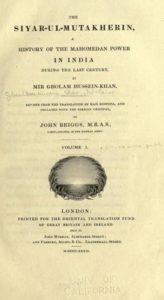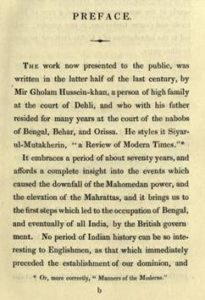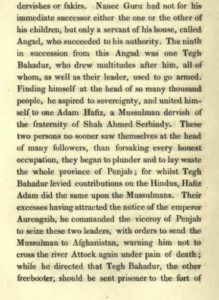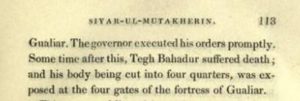The history of Guru Teg Bahadur in modern times is rampant with inaccuracies as the historical sources themselves aren't trustworthy
The earliest historical account of Teg Bahadur’s end and later narratives

Siyar-ul-Mutaʾaḫirīn of Ğulām Ḥusayn Ḫān Ṭabāṭabāʾī Ḥasanī
In this paper, we examine the earliest historical account of the death of the ninth Guru of the Sikhs—Teg Bahadur, around the year 1675 CE. Given the political landscape of North India at the time, we would expect accounts from two possible sources: the Sikh sources themselves, and the Persian sources (by Islamic historians).
There are no Sikh sources that are even within a century of the event. In that case, we must turn our attention to the Persian sources. The earliest account of this episode comes from the Siyar-ul-Mutaʾaḫirīn (Siyar) of Ğulām Ḥusayn Ḫān Ṭabāṭabāʾī Ḥasanī completed in AH 1197 (1781 CE).
The Siyar is a highly reputed source[1] for many reasons. Ğulām Ḥusayn Ḫān Ṭabāṭabāʾī Ḥasanī was born into an aristocratic Muslim (Shia) family in Delhi in around 1727 CE. He was from the nobility: his family was related to Alivardi Khan, with whom they migrated to Murshidabad in 1732[2]. His father was Bakshi of Zainuddin Ahmad Khan (son-in-law of Alivardi Khan). As such he would have had access to sources and accounts from higher levels of officialdom. He was also born in Delhi, less than 50 years after this event, and although he released the Siyar in 1781 CE, one would expect that work in gathering sources perhaps started much earlier.

At any rate, we have no earlier account, and as it happens, the account in the Siyar is sober and detailed. Ğulām Ḥusayn was also a well educated, widely travelled, and well-read. It is to be noted that the Siyar, for long, was a rare book, and manuscripts were hard to find[3]. It is for this reason that Sir Jadunath Sarkar seems to be unaware of the account provided in it. The lack of access to copies of this work for a long period of time also appears to have played a role in its historical account not being more widely known, even though it is the earliest (by far) and provided with good detail.

The Account of the Siyar
First, we reproduce the Siyar’s account and then expand upon supporting evidence.


To summarize, Teg Bahadur had teamed up with one Hafiz Adam, a follower of Sirhindi, and the combined followers of these two were plundering parts of Punjab. For this, they were both arrested, and while Hafiz Adam was banished towards today’s Afghanistan, Teg Bahadur was banished to Gwalior. There, he, for reasons not detailed, was finally executed.
The Evidence for the Siyar’s Account
In what follows, we will discuss the reasons why we find the above account of the Siyar to be believable.
First the internal evidence; by that we mean the evidence of the Siyar itself. Ğulām Ḥusayn has, before giving this account, given a detailed account of the previous Gurus. That account is on the whole, favourable, and therefore bespeaks to a fair manner of reporting of Sikhs in general. There is no trace of any prejudice towards Sikhs in general, and indeed he speaks of “Nanak Guru” with esteem. The verifiable details of that account are all accurate; the details of the succession of the Gurus are accurate. The level of detail in this particular account matches that of other episodes in the Siyar; it does not seem to be made up at a different level of detail than normal and therefore does not stand out as being inserted artificially. In addition, the Siyar provides an Islamic accomplice of Tegh Bahadur who is said to be his partner in collecting money from people. Therefore, it does not seem like a made-up account motivated by any religious impulse to tarnish Sikhs. Lastly, Ğulām Ḥusayn has been accused of being sympathetic to his fellow Shias in his history: if the alleged torture of Teg Bahadur by an avowedly Sunni monarch (Aurangzeb) were true, it is hard to believe that Ğulām Ḥusayn would have missed the chance to report it.
Next, we consider the external evidence in support of this account. Since the time of the fourth Guru Arjun, who had organized ‘masands’ to collect tithes from his followers and others who lived in their areas of influence, the gurus of the Sikhs had been collecting money from those who lived in their areas of power, as an informal taxation system. Given the brief confusion over the succession following the eighth Guru, with two claimants arising (Ram Rai and Teg Bahadur) and trying to get the favour of the Mughal throne to back their respective claims, it is expected that this system would have been briefly non-operational and defunct.
As such, it would be expected that once Teg Bahadur assumed the position of the Guru, he would have tried to revive the system of tithe collection of his predecessors. It seems this is what he was trying to do in partnership with Hafiz Adam: the account of the Siyar seems to be accurately depicting such a highly likely endeavour by Teg Bahadur.
Examination of later competing narratives
Let us examine the historical likelihood of competing accounts: specifically those where Teg Bahadur is arrested only for being a religious preacher. First and notable is that no other account is written even within 50 years after the Siyar. The Sikh accounts are from the early 19th century, and themselves seem to be interpolated even then. For example, the highly mythologized description of Teg Bahadur coming to the aid of persecuted Kashmiri Hindus only appears in the third edition of Gur Bilas Dasvin, not in the first two, and then only as late as 1848 CE. The first edition of Gur Bilas Dasvin by Sukha Singh is dated 1797 CE[4].
If we look at Aurangzeb’s reign, it is true that he revived the Jaziya and ordered large-scale destruction of temples. However, there are no records of him picking up Hindu preachers and executing them. And in a domain as vast as his, it is for sure that numerous Hindu preachers of various sects and beliefs preached. So it is hard to believe that Teg Bahadur was picked up for solely that reason.
That brings us to the possibility that he was picked up for resisting Aurangzeb’s proselytization in Kashmir—this is the account currently most narrated as part of the mythology of Teg Bahadur.
At the time of Teg Bahadur’s death, Kashmir had a liberal-minded Muslim ruler, whose right-hand man himself was Hindu[5]. In any case, the Islamization of the Kashmir valley had already taken place much earlier, during the rule of Sikandar ‘Butshikan.’
Another corroborating evidence comes from the Zafarnama[6], written by the son of Teg Bahadur, Govind Rai (later Govind Singh) to Aurangzeb himself. Had there been truth to the later mythologies whose salient features are (a) defence of Kashmiri Hindus and (b) torture, these would have been mentioned at least in Govind Singh’s long communication with the alleged perpetrator of these atrocities. The fact that Govind Singh speaks of so many issues, including his own perception of unfair treatment at the hands of Aurangzeb that led to the death of his children, yet he does not make any mention of the alleged (by later mythologies) murder of his own father Teg Bahadur. This would be hard to believe had the events of those later mythologies actually been true. Also, the claim that his father was killed merely for his religious position is at odds with the fact that Govind Singh tried incessantly to meet with Aurangzeb, sending him many letters, and was on his way to the Deccan to meet him when the latter (i.e., Aurangzeb) died. Had Teg Bahadur been treated as alleged by Aurangzeb, it is hardly likely that his son would be in such a need to meet him, knowing that his own fate might not be different.
Last, but not least, Aurangzeb was not present in Delhi/Agra for over a year around the time of the alleged beheading of Teg Bahadur. From the most definitive accounts of his reign—the Maasir-i-Alamgiri of Saqi Mustʾad Khan—, he departed towards Hasan Abdal from Delhi in June 1674 to quell the Yusufzai-Afridi uprising and returned to Delhi only in March 1676, that is, three months after the alleged beheading of Teg Bahadur “by him” in the later mythologized narrative. It would seem that the chance and unusual absence of Aurangzeb from Delhi precisely during this period was accidentally overlooked by those that authored the later narratives. The chronology of Aurangzeb is provided by Sarkar[7] from the Maasir-i-Alamgiri.

For these reasons, the alternative account, found in later Sikh hagiographies, may be regarded as highly unlikely. It seems to be a later interpolation, done around 150 years after the event, as part of the mythology-making around the Gurus of the Sikhs.
Conclusion
In conclusion, we feel that the account given in the Siyar is (a) the best available to us and (b) is actually reliable in the outline. It is certainly the earliest, and therefore on the weight of that alone, would be worthy of being taken very seriously. As we have discussed, the other pieces of evidence also point towards its veracity. It is easy to see why this earliest account would be “overwritten” (in a manner of speaking), by Sikh hagiographers, and replaced with another which is more panegyric. However, as discussed, not only does it appear much later than the account in the Siyar, historical evidence goes contrary to it.
Notes:
Interestingly, a similar attempt at rewriting happened recently[8], when several court petitions were filed against Bipan Chandra’s Medieval India for stating the account in the Siyar. The petitions objected to this account not on any historical grounds, but on the grounds that it “hurt the sentiments of a community.” The petition gathered enough strength to force the author to remove the account of the Siyar from the book. Needless to say, such politically motivated omission of accounts that do not suit the narratives being sought to be built is harmful to the pursuit of history: of what actually happened.
What of the Gurudwara Sisganj then? The current building dates only to around 1930 and is said to have been constructed on an older building that dates to the so-called “Delhi Fateh” of 1783. However, this latter event finds no mention in standard accounts of Delhi of that time, and the Sikh accounts first appear in a later hagiographic work, the Panth Prakash of Giani Gian Singh. Historical records of the late 18th century describe Sikhs as bands of looters and lawless raiders. During that time period, Delhi proper, especially the Red Fort and its surroundings, was in control of either the Marathas or the British. We have accounts of multiple sources, including the envoy of the East India Company who was stationed in the Red Fort. These do not corroborate the “Delhi Fateh” account. Instead, the records of around 1783 suggest only that Sikhs plundered and reached up till Barari[9][10][11]. We may surmise that “Delhi Fateh” is an exaggerated portrayal of this plundering raid.
Given that, the claim that (a) the spot of Teg Bahadur’s alleged beheading was identified and (b) a Gurudwara built during this excursion does not bear close historical scrutiny. Furthermore, even that raid was over 100 years after the death of Teg Bahadur, and so the accuracy of performing the aforementioned tasks, without any intermediate accounts, does not stand up to scrutiny. We feel that this is an area worthy of research interest.
Notes on Other Sources:
Macauliffe’s The Sikh Religion (in six volumes, 1909) was the first work in English to shed light on the history of the Sikhs. However, Macauliffe’s accounts are taken almost entirely only from Sikh hagiographies. As noted, these are much later to the event than the Siyar. It is also likely that the Siyar was not available to Macauliffe, since we find its lack of availability commented upon by several historians (Keene, Elliot, Bankim Chandra, to name but three).
Macauliffe’s history is, in turn, taken as the source by several histories that follow him. For example, Irvine’s Later Mughals takes Macauliffe as the source; however, it also makes note of the Siyar in footnotes. Irvine had held the publication of his history back to cross-check events of his accounts of Sikhs with the anticipated Macauliffe’s history and therefore does not deviate much from it. Sarkar also borrows entirely from Macauliffe, and notes that Persian histories are “silent on Teg Bahadur.”[12] Perhaps he was unaware of the account of Teg Bahadur’s execution in the Siyar.
In summary, these histories take only from Sikh hagiographical sources written almost 250 years after the events and do not provide any earlier source on the episode than the Siyar. In 1675, the relative insignificance of Sikhs accounts for most Persian sources being silent on this matter; but it also makes it highly unlikely that the personal attention to Teg Bahadur alleged in the Sikh hagiographies could be possible.
Anything that the Alamgir took such interest in would surely be noted and recorded in multiple contemporary accounts, but this is not the case.
References:
Note on Translations:
The Siyar is a Persian document. We have used two translations: the earliest translation into English by Briggs (who has also translated several other Persian MSS) as well as a later translation provided by the Packard Humanities foundation. Both match in the portion of the Siyar that we have used.
[1] For example, H. G. KEENE, writes—“This celebrated history is a work of surprising industry and contains many just reflections on the position of the English and the feelings of the people towards them, which are almost as true now as they were when written.”—The Fall of the Moghul Empire.
[2] National Encyclopedia of Bangladesh, entry on “Siyar-ul-Mutakhkherin”
[3] For example, SIR H. M. ELLIOT writes—“The author treats these important subjects with a freedom and with a force, clearness and simplicity of style very unusual in an Asiatic writer, and which justly entitles him to pre-eminence among Muhammadan historians. * * * It has long been a rare book, only to be found here and there in public libraries. It is greatly to be desired that a complete translation of this history should be accessible to the students of Indian history.
[4] This is different from the earlier Gur Bilas (Pathshahi) Dasvin by Kuir Singh, which is dated AD 1751 and does not contain the narrative of Teg Bahadur coming to the aid of Kashmiri Hindus
[5] See Bipan Chandra, “Medieval History”
[6] This letter from Govind Singh to Aurangzeb is also part of the Dasham Granth. Several translations into Hindi and English are available online.
[7] History of Aurangzeb, Vol III, pp. 393-394
[8] Multiple accounts exist, see for example https://www.indiatoday.in/magazine/nation/story/20011210-ncert-censors-politically-inconvenient-textbooks-but-banality-in-history-teaching-remains-774900-2001-12-10
[9] Sir Jadunath Sarkar, Fall of the Mughal Empire.
[10] See H. R. Gupta, History of the Sikhs, Vol II for more corroboration.
[11] This event has received some recent research attention, see Smita Mukerji, “Nishan Sahib on Red Fort”, Hrithambara January 2021
[12] Sir Jadunath Sarkar, History of Aurangzeb, Vol III.

Leave a Reply